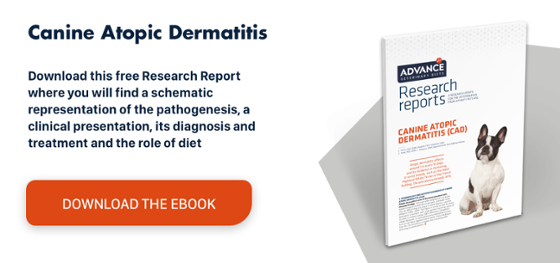Acral lick dermatitis: diagnosis and treatment
Acral lick dermatitis is a common condition in dogs, accounting for about 3% of dermatology cases seen in general practice.1
Introduction
Acral lick dermatitis (lick granuloma) is produced by excessive and compulsive licking in a certain area of the body.
It is a multifactorial disease and often frustrating because it affects the quality of life of both dogs and owners.
Although in most cases the disease’s development involves a psychogenic component (boredom, confinement, separation anxiety), it is generally triggered by an underlying organic disease (usually, but not always, of allergic origin).1,2
Clinical presentation
Acral lick dermatitis can affect dogs of any age and size, although it is mostly reported in large breeds, such as Doberman, Great Dane, Labrador and German Shepherd.
The lesions take hold on the limbs, typically on the dorsal aspect of the carpal, metacarpal, tarsal or metatarsal bones, and manifest as hard, alopecic, raised, clearly circumscribed, frequently erosive or ulcerated areas of skin.1,2
There is always a primary cause for a lick granuloma (which may be organic) that initiates the dog’s licking of the given area, plus a series of perpetuating factors (itch–lick cycle) that contribute to its persistence, even if the primary cause has disappeared.1
Diagnostic approach to patients with acral lick dermatitis
A good anamnesis and complete medical history will help identify the potential triggers of the disease. It is important to remember that up to 70% of dogs with acral lick dermatitis present some type of anxiety-related problem (living in confined spaces, lack of interaction or walks, etc.) that triggers the licking behaviour. Furthermore, a complete dermatological examination is necessary to diagnose any underlying diseases (especially allergies), coupled with orthopaedic and neurological exams, as joint pain or neuropathy could be behind the licking.1-3
A full range of laboratory tests (haematology, blood chemistry and urinalysis) can help exclude any endocrine diseases, while skin scrapes, trichograms, cytology and cultures may establish whether scabies, dermatophytes, secondary infections or even leishmaniasis or neoplasms are the underlying cause.1,2-4
Acral lick dermatitis: treatment
No single treatment is effective in controlling lick granuloma. The management of acral lick dermatitis should be designed to control both the primary cause and perpetuating factors, so that the itch–lick cycle can be broken.1
- It is essential to prevent the animal from licking the affected area. This can be achieved with physical barriers (Elizabethan collars, cervical collars, wearing socks or boots), applying topical substances with an unpleasant taste or using topical corticosteroid ointments or sprays with or without antibiotics. As most lesions are infected at the time of diagnosis, systemic antibiotics are recommended for 6–8 weeks. The intralesional administration of corticosteroids is contraindicated.1-3
- Many patients have an underlying allergy. So, if the medical history is suggestive of an allergy, recommendations are to rule out a food allergies through elimination diets or carry out allergen testing and subsequent immunotherapy, or treat atopic patients with oclacitinib, cyclosporine or lokivetmab.1-2
- If the patient has an orthopaedic problem, this should be corrected or nonsteroidal anti-inflammatories administered if this is not possible.1
- If the underlying cause has been controlled and the infection has resolved, but the lesion persists, laser ablation is another option. Conventional surgery is not recommended due to its associated complications.1
- Other treatment options include cryosurgery, radiation therapy, acupuncture, low-level laser therapy and behaviour modification techniques (increasing levels of activity and play), as well as the administration of psychotropic drugs, such as serotonin reuptake inhibitors and tricyclic antidepressants.1-3
Conclusions
The management of acral lick dermatitis is complex. As many cases combine an organic disease with a psychogenic problem, this often complicates treatment. It is very important to involve owners from the outset to achieve the right diagnosis and treatment. They need to understand that the dog is unlikely to lick in such a compulsive manner just because it is bored when left alone at home and there is probably an underlying disease, which will likely result in treatment failure unless it is found and treated. Consequently, they will be more likely to agree to the necessary diagnostic tests.

